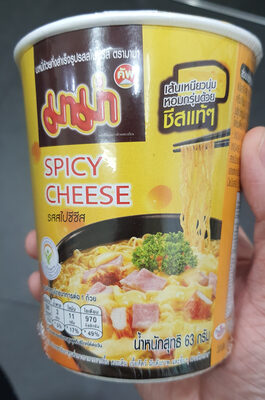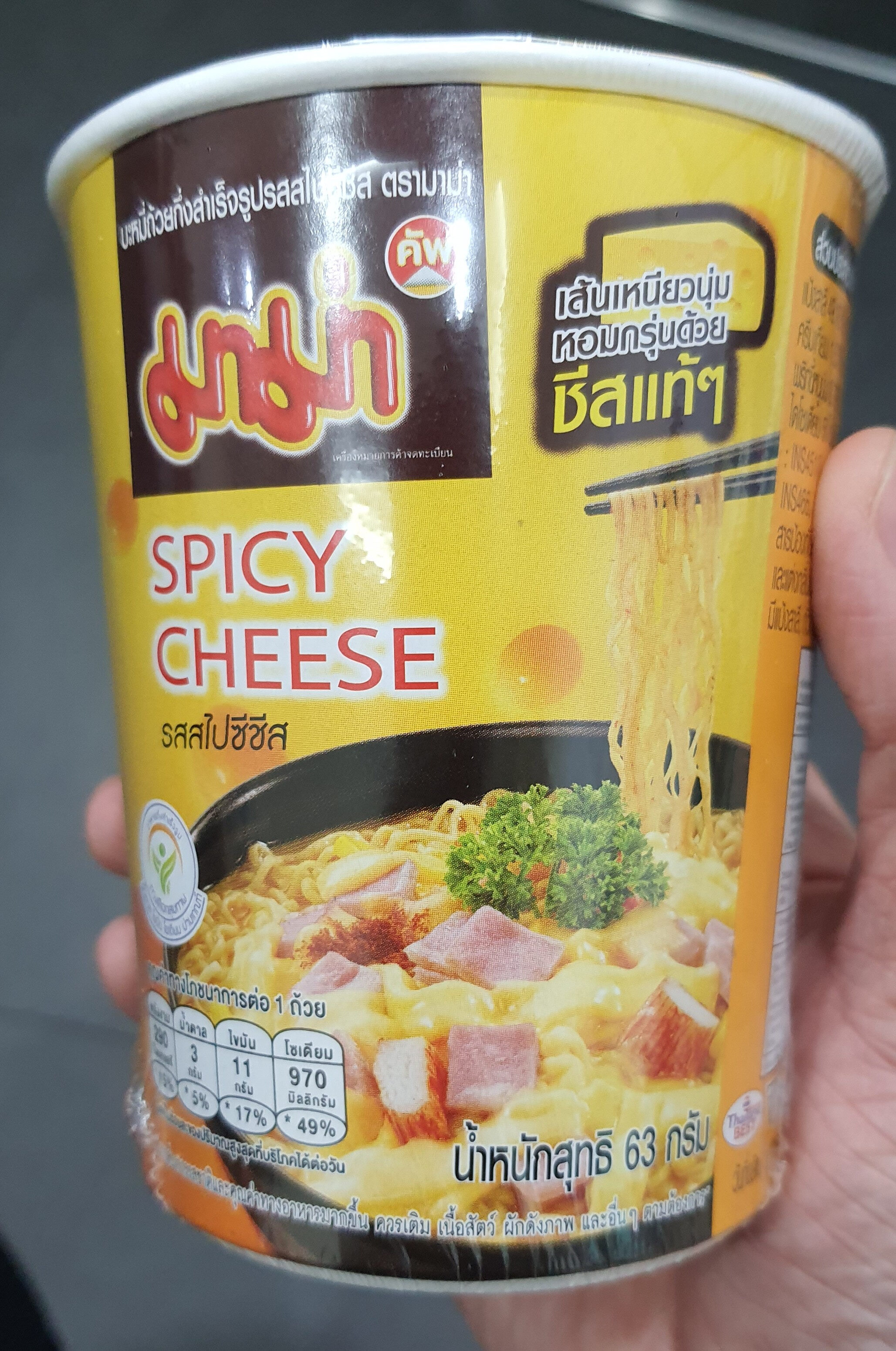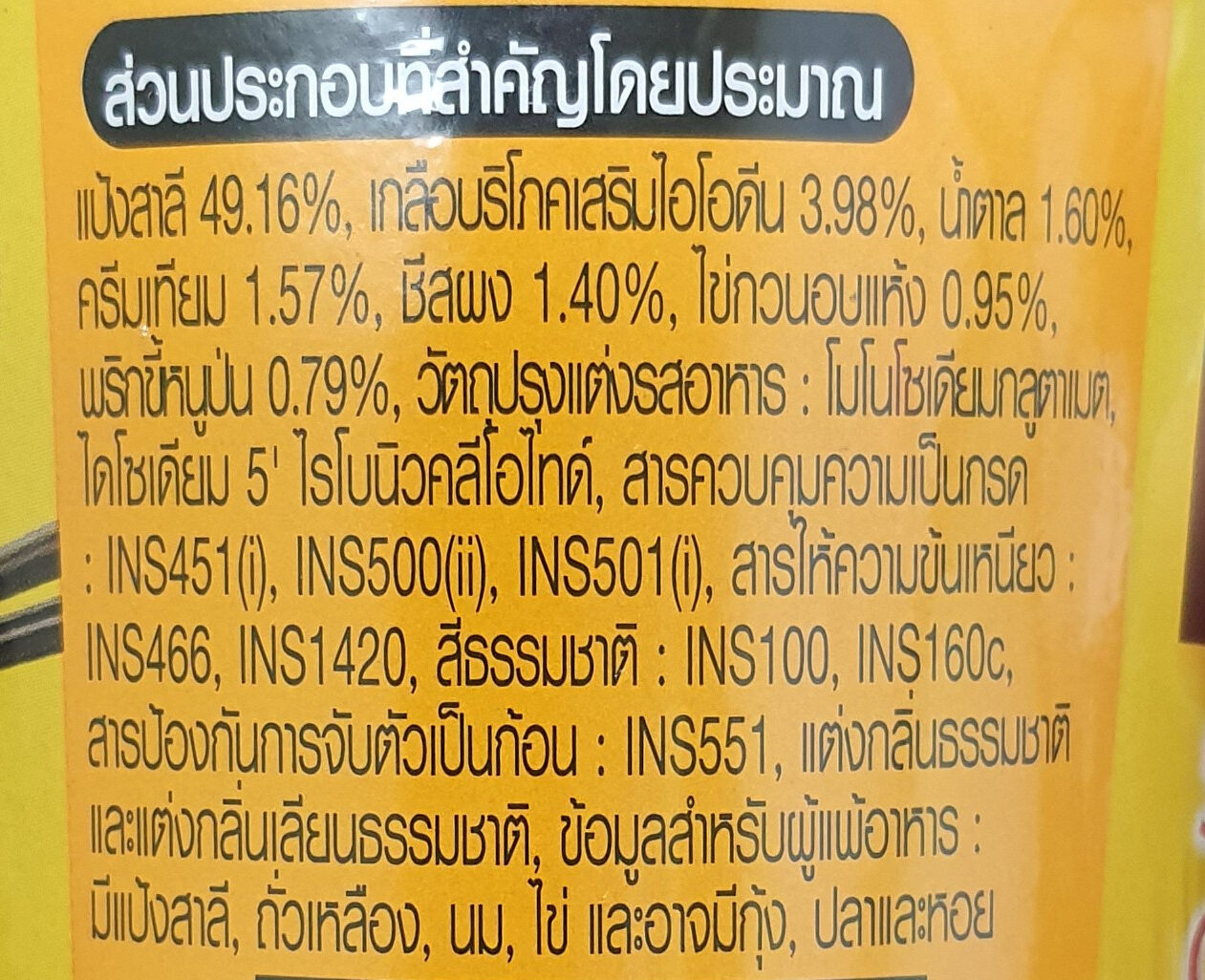Help us make food transparency the norm!
As a non-profit organization, we depend on your donations to continue informing consumers around the world about what they eat.
The food revolution starts with you!
บะหมี่กึ่งสำเร็จรูป รสสไปซี่ชีส - 63 g - Mama - 63g
บะหมี่กึ่งสำเร็จรูป รสสไปซี่ชีส - 63 g - Mama - 63g
This product page is not complete. You can help to complete it by editing it and adding more data from the photos we have, or by taking more photos using the app for Android or iPhone/iPad. Thank you!
×
Barcode: 8850987144998 (EAN / EAN-13)
Quantity: 63g
Packaging: Pot
Categories: Plant-based foods and beverages, Plant-based foods, Cereals and potatoes, Cereals and their products, Dried products, Pastas, Dried products to be rehydrated, Noodles, Instant noodles
Countries where sold: Thailand
Matching with your preferences
Health
Ingredients
-
19 ingredients
: ส่วนประกอบที่สำคัญโดยประมาณ แป้งสาลี 49.16%, เกลือบริโภคเสริมไอโอดีน 3.98%, น้ำตาล 1,00%. ครีมเทียม 1.57%, ชีสผง 1.40%, ไข่กวนอบแห้ง 0.95% พริกขี้หนูป่น 0.79%, วัตถุปรุงแต่งรสอาหาร : โมโนโซเดียมกลูตาเมต ไดโซเดียม 5 ไรโบนิวคลีโอไทด์, สารควบคุมความเป็นกรด - INS4510), INS500i), INS501), สารให้ความข้นเหนียว INS466, INS1420. สีธรรมชาติ : INS100, INS160c สารป้องกันการจับตัวเป็นก้อน : INS551, แต่งกลิ่นธรรมชาติ และแต่งกลิ่นเลียนธรรมชาติAllergens: Crustaceans, Eggs, Fish, Gluten, Milk, Soybeans, Shell
Food processing
-
Ultra processed foods
Elements that indicate the product is in the 4 - Ultra processed food and drink products group:
- Additive: E100 - Curcumin
- Additive: E1420 - Acetylated starch
- Additive: E551 - Silicon dioxide
Food products are classified into 4 groups according to their degree of processing:
- Unprocessed or minimally processed foods
- Processed culinary ingredients
- Processed foods
- Ultra processed foods
The determination of the group is based on the category of the product and on the ingredients it contains.
Additives
-
E500 - Sodium carbonates
Sodium carbonates (E500) are compounds commonly used in food preparation as leavening agents, helping baked goods rise by releasing carbon dioxide when they interact with acids.
Often found in baking soda, they regulate the pH of food, preventing it from becoming too acidic or too alkaline. In the culinary world, sodium carbonates can also enhance the texture and structure of foods, such as noodles, by modifying the gluten network.
Generally recognized as safe, sodium carbonates are non-toxic when consumed in typical amounts found in food.
-
E500i - Sodium carbonate
Sodium carbonate: Sodium carbonate, Na2CO3, -also known as washing soda, soda ash and soda crystals, and in the monohydrate form as crystal carbonate- is the water-soluble sodium salt of carbonic acid. It most commonly occurs as a crystalline decahydrate, which readily effloresces to form a white powder, the monohydrate. Pure sodium carbonate is a white, odorless powder that is hygroscopic -absorbs moisture from the air-. It has a strongly alkaline taste, and forms a moderately basic solution in water. Sodium carbonate is well known domestically for its everyday use as a water softener. Historically it was extracted from the ashes of plants growing in sodium-rich soils, such as vegetation from the Middle East, kelp from Scotland and seaweed from Spain. Because the ashes of these sodium-rich plants were noticeably different from ashes of timber -used to create potash-, they became known as "soda ash". It is synthetically produced in large quantities from salt -sodium chloride- and limestone by a method known as the Solvay process. The manufacture of glass is one of the most important uses of sodium carbonate. Sodium carbonate acts as a flux for silica, lowering the melting point of the mixture to something achievable without special materials. This "soda glass" is mildly water-soluble, so some calcium carbonate is added to the melt mixture to make the glass produced insoluble. This type of glass is known as soda lime glass: "soda" for the sodium carbonate and "lime" for the calcium carbonate. Soda lime glass has been the most common form of glass for centuries. Sodium carbonate is also used as a relatively strong base in various settings. For example, it is used as a pH regulator to maintain stable alkaline conditions necessary for the action of the majority of photographic film developing agents. It acts as an alkali because when dissolved in water, it dissociates into the weak acid: carbonic acid and the strong alkali: sodium hydroxide. This gives sodium carbonate in solution the ability to attack metals such as aluminium with the release of hydrogen gas.It is a common additive in swimming pools used to raise the pH which can be lowered by chlorine tablets and other additives which contain acids. In cooking, it is sometimes used in place of sodium hydroxide for lyeing, especially with German pretzels and lye rolls. These dishes are treated with a solution of an alkaline substance to change the pH of the surface of the food and improve browning. In taxidermy, sodium carbonate added to boiling water will remove flesh from the bones of animal carcasses for trophy mounting or educational display. In chemistry, it is often used as an electrolyte. Electrolytes are usually salt-based, and sodium carbonate acts as a very good conductor in the process of electrolysis. In addition, unlike chloride ions, which form chlorine gas, carbonate ions are not corrosive to the anodes. It is also used as a primary standard for acid-base titrations because it is solid and air-stable, making it easy to weigh accurately.Source: Wikipedia
-
E501 - Potassium carbonates
Potassium carbonate: Potassium carbonate -K2CO3- is a white salt, which is soluble in water -insoluble in ethanol- and forms a strongly alkaline solution. It can be made as the product of potassium hydroxide's absorbent reaction with carbon dioxide. It is deliquescent, often appearing a damp or wet solid. Potassium carbonate is used in the production of soap and glass.Source: Wikipedia
-
E551 - Silicon dioxide
Silicon dioxide: Silicon dioxide, also known as silica, silicic acid or silicic acid anydride is an oxide of silicon with the chemical formula SiO2, most commonly found in nature as quartz and in various living organisms. In many parts of the world, silica is the major constituent of sand. Silica is one of the most complex and most abundant families of materials, existing as a compound of several minerals and as synthetic product. Notable examples include fused quartz, fumed silica, silica gel, and aerogels. It is used in structural materials, microelectronics -as an electrical insulator-, and as components in the food and pharmaceutical industries. Inhaling finely divided crystalline silica is toxic and can lead to severe inflammation of the lung tissue, silicosis, bronchitis, lung cancer, and systemic autoimmune diseases, such as lupus and rheumatoid arthritis. Uptake of amorphous silicon dioxide, in high doses, leads to non-permanent short-term inflammation, where all effects heal.Source: Wikipedia
Ingredients analysis
-
Palm oil content unknown
Unrecognized ingredients: th:ส่วนประกอบที่สำคัญโดยประมาณ-แป้งสาลี, th:เกลือบริโภคเสริมไอโอดีน, th:ครีมเทียม, th:ชีสผง, th:ไข่กวนอบแห้ง-0-95-พริกขี้หนูป่น, th:วัตถุปรุงแต่งรสอาหาร, th:โมโนโซเดียมกลูตาเมต-ไดโซเดียม-5-ไรโบนิวคลีโอไทด์, th:สารควบคุมความเป็นกรด, th:e4510, th:สารให้ความข้นเหนียว-e466, th:สีธรรมชาติ, th:e160c-สารป้องกันการจับตัวเป็นก้อน, th:แต่งกลิ่นธรรมชาติ-และแต่งกลิ่นเลียนธรรมชาติSome ingredients could not be recognized.
We need your help!
You can help us recognize more ingredients and better analyze the list of ingredients for this product and others:
- Edit this product page to correct spelling mistakes in the ingredients list, and/or to remove ingredients in other languages and sentences that are not related to the ingredients.
- Add new entries, synonyms or translations to our multilingual lists of ingredients, ingredient processing methods, and labels.
If you would like to help, join the #ingredients channel on our Slack discussion space and/or learn about ingredients analysis on our wiki. Thank you!
-
Vegan status unknown
Unrecognized ingredients: th:ส่วนประกอบที่สำคัญโดยประมาณ-แป้งสาลี, th:เกลือบริโภคเสริมไอโอดีน, th:ครีมเทียม, th:ชีสผง, th:ไข่กวนอบแห้ง-0-95-พริกขี้หนูป่น, th:วัตถุปรุงแต่งรสอาหาร, th:โมโนโซเดียมกลูตาเมต-ไดโซเดียม-5-ไรโบนิวคลีโอไทด์, th:สารควบคุมความเป็นกรด, th:e4510, th:สารให้ความข้นเหนียว-e466, th:สีธรรมชาติ, th:e160c-สารป้องกันการจับตัวเป็นก้อน, th:แต่งกลิ่นธรรมชาติ-และแต่งกลิ่นเลียนธรรมชาติSome ingredients could not be recognized.
We need your help!
You can help us recognize more ingredients and better analyze the list of ingredients for this product and others:
- Edit this product page to correct spelling mistakes in the ingredients list, and/or to remove ingredients in other languages and sentences that are not related to the ingredients.
- Add new entries, synonyms or translations to our multilingual lists of ingredients, ingredient processing methods, and labels.
If you would like to help, join the #ingredients channel on our Slack discussion space and/or learn about ingredients analysis on our wiki. Thank you!
-
Vegetarian status unknown
Unrecognized ingredients: th:ส่วนประกอบที่สำคัญโดยประมาณ-แป้งสาลี, th:เกลือบริโภคเสริมไอโอดีน, th:ครีมเทียม, th:ชีสผง, th:ไข่กวนอบแห้ง-0-95-พริกขี้หนูป่น, th:วัตถุปรุงแต่งรสอาหาร, th:โมโนโซเดียมกลูตาเมต-ไดโซเดียม-5-ไรโบนิวคลีโอไทด์, th:สารควบคุมความเป็นกรด, th:e4510, th:สารให้ความข้นเหนียว-e466, th:สีธรรมชาติ, th:e160c-สารป้องกันการจับตัวเป็นก้อน, th:แต่งกลิ่นธรรมชาติ-และแต่งกลิ่นเลียนธรรมชาติSome ingredients could not be recognized.
We need your help!
You can help us recognize more ingredients and better analyze the list of ingredients for this product and others:
- Edit this product page to correct spelling mistakes in the ingredients list, and/or to remove ingredients in other languages and sentences that are not related to the ingredients.
- Add new entries, synonyms or translations to our multilingual lists of ingredients, ingredient processing methods, and labels.
If you would like to help, join the #ingredients channel on our Slack discussion space and/or learn about ingredients analysis on our wiki. Thank you!
-
Details of the analysis of the ingredients
We need your help!
Some ingredients could not be recognized.
We need your help!
You can help us recognize more ingredients and better analyze the list of ingredients for this product and others:
- Edit this product page to correct spelling mistakes in the ingredients list, and/or to remove ingredients in other languages and sentences that are not related to the ingredients.
- Add new entries, synonyms or translations to our multilingual lists of ingredients, ingredient processing methods, and labels.
If you would like to help, join the #ingredients channel on our Slack discussion space and/or learn about ingredients analysis on our wiki. Thank you!
: ส่วนประกอบที่สำคัญโดยประมาณ แป้งสาลี 49.16%, เกลือบริโภคเสริมไอโอดีน 3.98%, น้ำตาล 1%, ครีมเทียม 1.57%, ชีสผง 1.4%, ไข่กวนอบแห้ง 0.95% พริกขี้หนูป่น 0.79%, วัตถุปรุงแต่งรสอาหาร (โมโนโซเดียมกลูตาเมต ไดโซเดียม 5 ไรโบนิวคลีโอไทด์), สารควบคุมความเป็นกรด, e4510, e500i, e501, สารให้ความข้นเหนียว e466, e1420, สีธรรมชาติ (e100), e160c สารป้องกันการจับตัวเป็นก้อน (e551), แต่งกลิ่นธรรมชาติ และแต่งกลิ่นเลียนธรรมชาติ- ส่วนประกอบที่สำคัญโดยประมาณ แป้งสาลี -> th:ส่วนประกอบที่สำคัญโดยประมาณ-แป้งสาลี - percent: 49.16
- เกลือบริโภคเสริมไอโอดีน -> th:เกลือบริโภคเสริมไอโอดีน - percent: 3.98
- น้ำตาล -> en:sugar - vegan: yes - vegetarian: yes - ciqual_proxy_food_code: 31016 - percent: 1
- ครีมเทียม -> th:ครีมเทียม - percent: 1.57
- ชีสผง -> th:ชีสผง - percent: 1.4
- ไข่กวนอบแห้ง 0.95% พริกขี้หนูป่น -> th:ไข่กวนอบแห้ง-0-95-พริกขี้หนูป่น - percent: 0.79
- วัตถุปรุงแต่งรสอาหาร -> th:วัตถุปรุงแต่งรสอาหาร
- โมโนโซเดียมกลูตาเมต ไดโซเดียม 5 ไรโบนิวคลีโอไทด์ -> th:โมโนโซเดียมกลูตาเมต-ไดโซเดียม-5-ไรโบนิวคลีโอไทด์
- สารควบคุมความเป็นกรด -> th:สารควบคุมความเป็นกรด
- e4510 -> th:e4510
- e500i -> en:e500i - vegan: yes - vegetarian: yes
- e501 -> en:e501 - vegan: yes - vegetarian: yes
- สารให้ความข้นเหนียว e466 -> th:สารให้ความข้นเหนียว-e466
- e1420 -> en:e1420 - vegan: yes - vegetarian: yes
- สีธรรมชาติ -> th:สีธรรมชาติ
- e100 -> en:e100 - vegan: yes - vegetarian: yes
- e160c สารป้องกันการจับตัวเป็นก้อน -> th:e160c-สารป้องกันการจับตัวเป็นก้อน
- e551 -> en:e551 - vegan: yes - vegetarian: yes
- แต่งกลิ่นธรรมชาติ และแต่งกลิ่นเลียนธรรมชาติ -> th:แต่งกลิ่นธรรมชาติ-และแต่งกลิ่นเลียนธรรมชาติ
-
Nutrition facts
Nutrition facts As sold
for 100 g / 100 mlAs sold
per serving (63 g)Compared to: Instant noodles Energy 1,930 kj
(460 kcal)1,213.36 kj
(290 kcal)+53% Fat 17.5 g 11 g +56% Saturated fat 7.94 g 5 g +60% Cholesterol 7.94 mg 5 mg +678% Carbohydrates 66.7 g 42 g +59% Sugars 4.76 g 3 g +87% Fiber 1.59 g 1 g -22% Proteins 7.94 g 5 g +22% Salt 3.85 g 2.425 g +46% Vitamin A 0 µg 0 µg (0 % DV) -100% Vitamin B1 (Thiamin) 9,520 mg 6,000 mg (6 % DV) +1,084% Vitamin B2 (Riboflavin) 0 mg 0 mg (0 % DV) -100% Calcium 31.7 mg 20 mg (2 % DV) -1% Iron 0.571 mg 0.36 mg (2 % DV) -79% Fruits‚ vegetables‚ nuts and rapeseed‚ walnut and olive oils (estimate from ingredients list analysis) 0 % 0 %
Environment
-
Eco-Score B - Low environmental impact
⚠ ️Select a country in order to include the full impact of transportation.The Eco-Score is an experimental score that summarizes the environmental impacts of food products.→ The Eco-Score was initially developped for France and it is being extended to other European countries. The Eco-Score formula is subject to change as it is regularly improved to make it more precise and better suited to each country.Life cycle analysis
-
Average impact of products of the same category: A (Score: 82/100)
Category: Asian noodles, flavoured, dehydrated
Category: Asian noodles, flavoured, dehydrated
- PEF environmental score: 0.26 (the lower the score, the lower the impact)
- including impact on climate change: 1.67 kg CO2 eq/kg of product
Stage Impact Agriculture
65.5 %Processing
20.6 %Packaging
8.7 %Transportation
3.5 %Distribution
1.8 %Consumption
0.0 %
Bonuses and maluses
-
Missing origins of ingredients information
Malus: -5
⚠ ️ The origins of the ingredients of this product are not indicated.
If they are indicated on the packaging, you can modify the product sheet and add them.
If you are the manufacturer of this product, you can send us the information with our free platform for producers.
-
Missing packaging information for this product
Malus: -15
⚠ ️ The information about the packaging of this product is not filled in.⚠ ️ For a more precise calculation of the Eco-Score, you can modify the product page and add them.
If you are the manufacturer of this product, you can send us the information with our free platform for producers.
Eco-Score for this product
-
Impact for this product: B (Score: 62/100)
Product: บะหมี่กึ่งสำเร็จรูป รสสไปซี่ชีส - 63 g - Mama - 63g
Life cycle analysis score: 82
Sum of bonuses and maluses: -20
Final score: 62/100
-
Carbon footprint
-
Equal to driving 0.9 km in a petrol car
167 g CO² per 100g of product
The carbon emission figure comes from ADEME's Agribalyse database, for the category: Asian noodles, flavoured, dehydrated (Source: ADEME Agribalyse Database)
Stage Impact Agriculture
61.0 %Processing
14.9 %Packaging
16.3 %Transportation
6.8 %Distribution
1.0 %Consumption
0.0 %
Packaging
-
Missing packaging information for this product
⚠ ️ The information about the packaging of this product is not filled in.Take a photo of the recycling information Take a photo of the recycling information
Transportation
-
Origins of ingredients
Missing origins of ingredients information
⚠ ️ The origins of the ingredients of this product are not indicated.
If they are indicated on the packaging, you can modify the product sheet and add them.
If you are the manufacturer of this product, you can send us the information with our free platform for producers.Add the origins of ingredients for this product Add the origins of ingredients for this product
Report a problem
-
Incomplete or incorrect information?
Category, labels, ingredients, allergens, nutritional information, photos etc.
If the information does not match the information on the packaging, please complete or correct it. Open Food Facts is a collaborative database, and every contribution is useful for all.
Data sources
Product added on by bank-pc
Last edit of product page on by mosssck.
Product page also edited by openfoodfacts-contributors.








